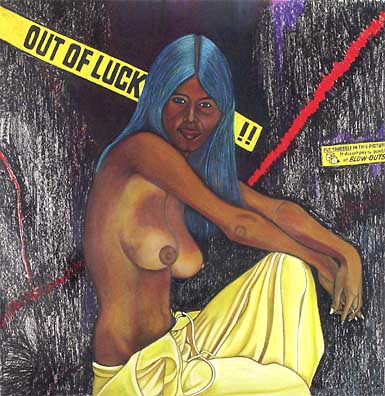
Current Issue Highlights More Readings DA Home About Direct Art
Art and Luck
by Robert Smythe

"Out of Luck," by EJ Robinson, oil pastel, 54" x 52"
In art, as in most fields of human endeavor, luck has a great deal to do with a person’s ability to succeed. Not in terms of a success measured in artistic skill or accomplishment, but in terms of being professionally recognized by the art establishment.
In the Renaissance for example, if one was lucky enough to be born to a cosmopolitan family with a certain level of social connections (and also had a measure of artistic talent,) the opportunity to enter the workshop of a respected master might present itself. An unlucky person may have been born instead to the house of a peasant. Such a person would never learn to read or draw. No amount of talent would save this person from a destiny of hard labor—raising pigs, or hacking at the earth with a rickety plow.
Today luck can play a similar role in the ability of an artist to succeed. Take the artist David for example, who was lucky enough to be born to a successful, upper-class American family. David was one of two children and was doted on his whole life. As a child the little drawings he made were praised, framed and hung on the wall. He received private art lessons and was sent to the best private schools. His interest in art was encouraged. He was sent to a top Ivy League College where he made connections with influential art personages.
On graduating, David’s wealthy parents gave him a Manhattan loft as a gift. Through the family’s social connections he was introduced to "important" art dealers as an up and coming talent. He was soon featured in exhibitions at exclusive galleries and was reviewed in major newspapers and magazines. David, who never worked a day in his life and whose artwork is exceedingly dull, is a successful Manhattan artist.
Tom, on the other hand, is an unlucky artist. He was born to a large family much lower on the economic ladder. Not only was there no money to send him to well connected colleges, but his family discouraged him from becoming an artist. He received no support and spent his early career living in decrepit apartments and doing construction work. Tom is very talented, but his art work is rarely exhibited. When it is shown it is usually in small off beat galleries that are not written about in any top magazines or newspapers.
Of course, both these artists are luckier than most. They had the luck to be born both white and male which gives them a distinct advantage. If you are unlucky enough to be born black, or worse yet, a woman and black, your odds of being a success in New York are greatly reduced. If we look at the roster of any top New York gallery this becomes obvious.
The Mary Boone gallery, a top Manhattan gallery in the trendy Chelsea neighborhood is one example. The gallery artists are all pictured on the gallery web site at www.maryboonegallery.com. There are 18 of them, all white except one black man named Leonardo Drew. In his picture he wears a funny looking hat. While the other artists (all white and without funny hats) have links to pages that display pictures of their work and listings of exhibits, Leonardo’s picture has no link. All he gets is a tiny picture, the lone black guy in a goofy hat.
Of course Leonardo is really lucky, after all he is there in the Mary Boone Gallery. Thousands upon thousands of black artists will never be exhibited anywhere except in black-only frame shops, or galleries found only in black urban neighborhoods, or on black art web sites marketing black-only art to only black customers.
Many years ago black-only restaurants, black-only bathrooms, black-only water fountains, black-only in the back of the bus, were all banned as racist. Yet, at the top of the American art world, white-only art is still the rule. Is this racism or just coincidence? Many art dealers claim this is due to "social conditions" that limit blacks from the pursuit of the arts - but this is a claim typically made by whites.
Of course all these artists, white, black, yellow, red or green are all luckier than Bob. Bob was an artist who moved to New York City from Indiana. One night he was walking to a restaurant near 23rd Street and a twelve pound bag of plaster fell off a construction scaffold ten flights up. It landed smack—right on his head. Needless to say he won’t be showing in a New York City gallery anytime soon.
Current Issue Highlights More Readings DA Home About Direct Art